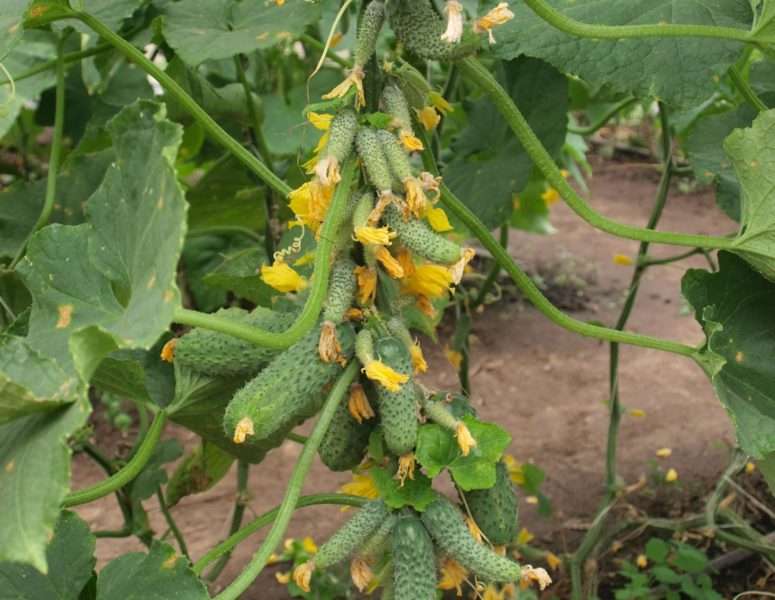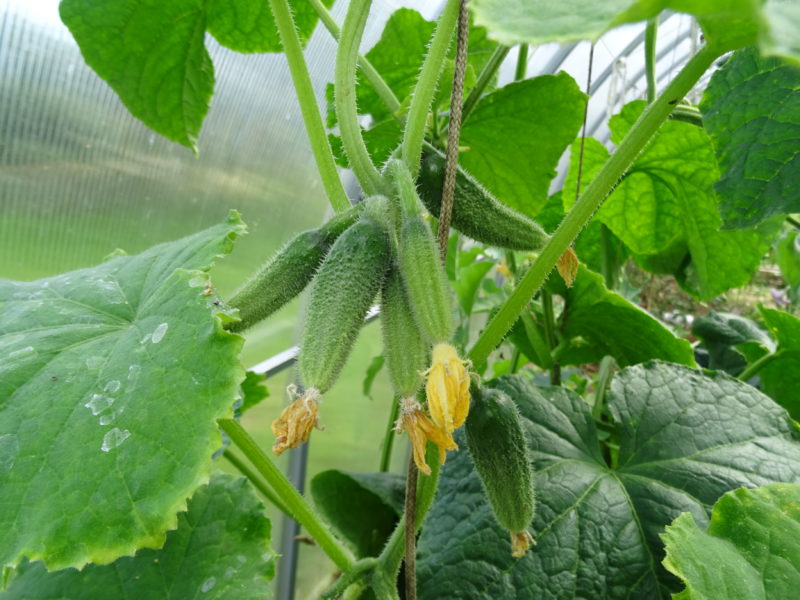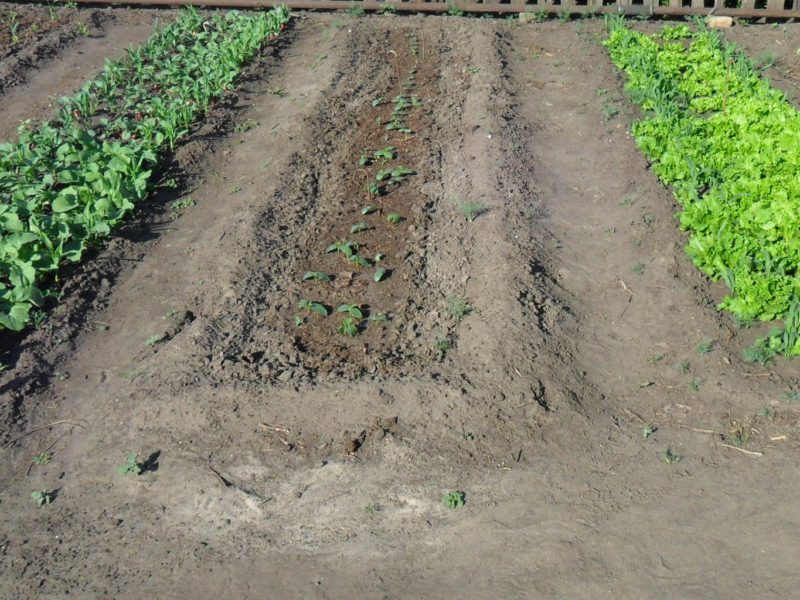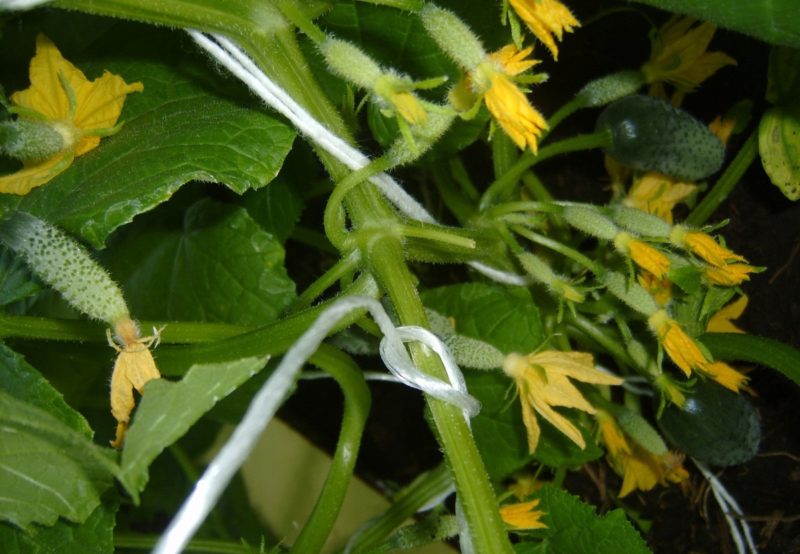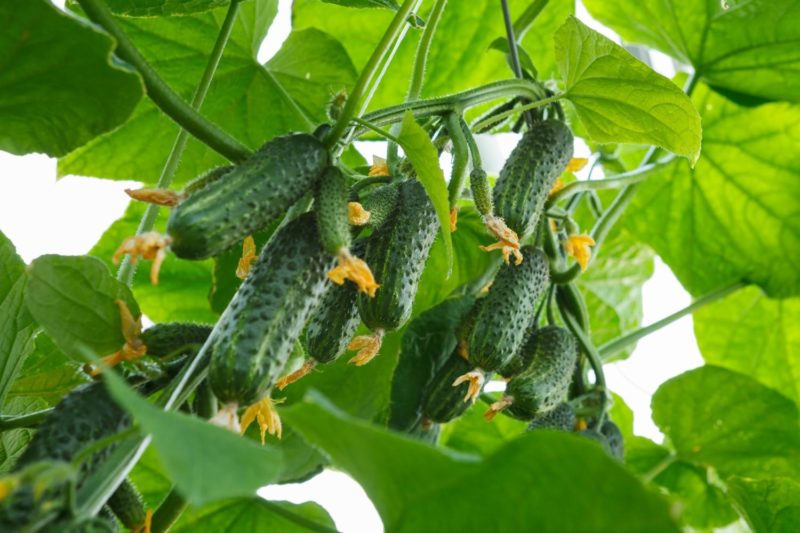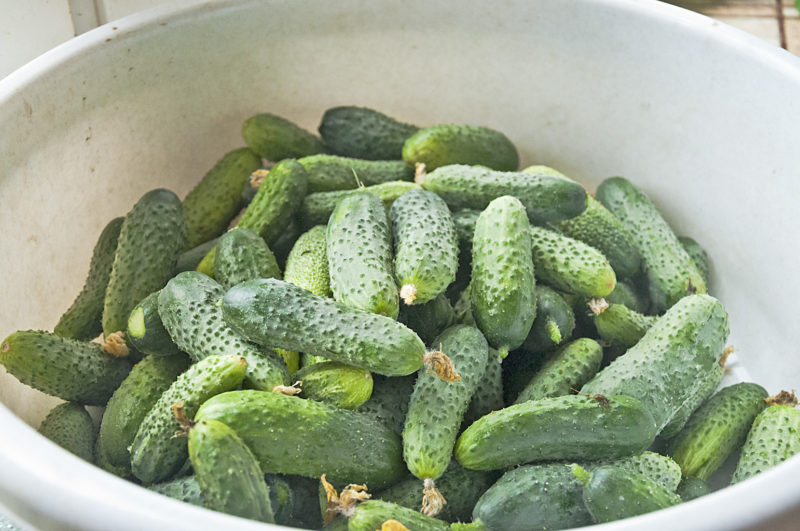Among the huge variety of cucumber species, the special attention of gardeners is attracted by the novelty of the Chelyabinsk breeders - hybrid cucumbers Siberian garland. This unique species has a plentiful harvest with minimal use of the planted area and in extreme soil and climatic conditions. Producers call the vegetable a cucumber of the future.
Material Content:
Description and features of the variety
The Siberian garland variety is intended for cultivation on trellises in greenhouse conditions and for open ground, differs from other cucumber species in external signs and properties.
The compactness of the plant is achieved by artificially forming a bush in one stem, removing all subordinate shoots. Short internodes located at a distance of 8 cm from each other along a powerful cucumber whip, about 1 cm thick, increase the number of future ovaries.
Unlike other varieties, this culture is shady. Its five-lobed leaves have long cuttings to shade from direct sunlight bouquets of several female flowers that open in the axils of the internodes, in the future - cucumber ovaries.
Small leaves, with a diameter of about 10 cm, contribute to less moisture evaporation, protecting the plant at low humidity during dry periods.
The fruits formed by the bunches are evenly distributed over the 2-meter stalk, represent the form of a garland, which justifies the name of the variety. Cucumbers with excellent taste and a pronounced aroma are also good-looking - even, 6-8 cm long, up to 1 cm thick.The peel is tender, but strong, light green at the tip, darkening to the base, covered with pimples with characteristic white and soft “spines”.
Due to the rapid growth and short ripening period - only 41 - 45 days from planting to ripeness of the first fruit - the collection of vegetables is early and long, pickles are removed in greenhouses right up to frosts.
Self-pollinated culture is able to grow in closed and open ground. The compact size, the formation of plants in one stem allows you to grow them in small areas, for example, on the balcony, receiving up to 20 kg of greenery from the bush per season. To increase productivity, an important condition is the daily collection of vegetables and proper agricultural technology.
Advantages and disadvantages
Relative to other varieties, the cucumber Siberian garland F1 has clear advantages:
- increased productivity - with regular removal of greenery and careful attention to the plant, each bush is able to produce about 4 hundred pieces per season, since up to 10 or more ovaries can form in one internode;
- fruiting uniform throughout the growing season;
- adapted to the vagaries of nature - tolerate aridity of the soil, prolonged rainfall, temperature extremes, lack of sun;
- resistant to fungi, viruses and parasitic insects;
- excellent safety and transportation properties.
Beam cucumbers themselves are uncharacteristic of overgrowing, they do not increase more than the size of a gherkin, remain dense, without voids, as juicy, crunchy and without a specific bitterness (genetically laid). Suitable for any dish and heat treatment.
There are some flaws in the variety. Without proper daily harvest of vegetables, productivity is reduced.
The formation of cucumbers is necessary - regular pinching of stepsons and antennae along the entire height of the stem.
Like any other hybrid, cucumbers lack full seeds. They must be purchased annually through a distribution network, and the price of material for planting cucumbers Siberian garland even at the manufacturer is very high.
Choosing a place and preparing the garden
To achieve a rich harvest of Siberian garland cucumbers, it is necessary to take into account the peculiarities of cultivation. Negative attitude to direct sunlight, increased requirements for soil composition make us pay special attention to the choice of a place for planting in open ground.
First of all, the bed should be in partial shade. If this is not possible, then it is imperative to pritenit, including and in an artificial way. For example, plant a row of corn or sunflower in front of cucumbers.
Tip. Observe crop rotation. Do not plant cucumbers on ridges where pumpkin crops used to grow, but legumes, nightshade and onion sets will be excellent predecessors.
The soil should be fertile, pass water and air well, with neutral acidity. Prepare ridges in advance. When digging, make rotted manure or compost soil and mineral fertilizers (superphosphate and potassium salt). The soil is well shed, covered with a film and left for 10-14 days.
How to plant
The Siberian garland variety is suitable for planting seeds directly into the soil, and the seedling method is also applicable to get an earlier crop.
It is possible to plant seeds in open ground only in warmed up soil, when return frosts pass. Before starting work, seeds must be soaked in warm water. When the roots appear, plant on the ridges with the calculation of 2 plants per meter, deepening the seed by 2-3 cm. Then you need to pour everything with warm water and do not forget about the covering material.
Seeds are planted on seedlings 2.5–3 weeks before planting in a greenhouse or in a garden.
The following rules are considered:
- It is allowed to use both individual containers and common containers.
- Hatching seeds are planted.
- Landing creates a greenhouse effect.
- Daily ventilation, removal of condensate, moistening of the soil when drying is necessary.
For the viability of seedlings, it is necessary to maintain an air temperature of at least +22. It is useful to feed the sprouts with an aqueous solution of urea (2 g / 1 l) every 10 days.
You can plant seedlings in the ground warmed up to +10 - +15 and prepared pits at a distance of 50 cm from each other. Tamp the soil tightly around the seedling, water it.
If open ground is chosen for seedlings of cucumbers, plantings must be covered with a spanbond until new leaves appear.
While the seedlings are small, they set trellises in advance, so that it is more convenient to form a bush.
Cucumber care “Siberian garland F1”
The agricultural technology behind beam cucumbers is slightly different from ordinary varieties.
The formation of the bush takes place in one stem, providing uniform illumination, ventilation, easing the load on the plant, thereby increasing the likelihood of new ovaries. To do this, cut off all the stepsons and antennae completely to the point of growth, leaving only flower buds. The top of the cucumber whip is wrapped 2-3 times around the upper horizontal twine and pinched.
During the growing season, it is necessary to regularly water the cucumbers with necessarily warm water so that the roots do not rot. Sprinkling is contraindicated for them, it is better to equip with drip irrigation or directly under the root (3-5 liters of water per plant).
Important to increase productivity are top dressing, which suit at least 4 times per season.
- Do this after the seedlings have taken root, after 2 weeks or the appearance of 2 pairs of true leaves when sowing seeds. Nitrogen fertilizers are used to stimulate the growth of vegetative parts: infusion of mullein 1:10, ammofoska 6 g / m2.
- At the beginning of flowering, complexes with a predominance of phosphorus and potassium are used.
- When the first cucumbers appear, they are fed with potash fertilizers to strengthen the fruits and increase new ovaries.
- After another 10 days, you can fertilize with a complex with a predominance of potassium and phosphorus to stimulate fruiting.
All formulations should not contain chlorine.
Do not forget about loosening the soil so that a crust does not form on the surface of the soil, which interferes with the access of air to the roots. Time to remove weeds that take away food from the fruit.
Only a careful attitude and compliance with all the rules of agricultural technology will allow you to collect a plentiful crop of cucumbers of the Siberian garland.
Diseases, pests and methods of dealing with them
Chelyabinsk breeders made a huge gift to gardeners, creating at the genetic level the resistance of the hybrid to numerous diseases, such as cucumber mosaic, spotting, peronosporosis, powdery mildew.
Adverse climatic conditions, lack of care and violation of agricultural requirements can lead to root and gray rot, attack of insect pests.
Preventive treatments with safe biologics such as Fitoverm mixed with green soap will prevent the attack of aphids, thrips, spider mites, minion flies and other cucumber enemies.
Prevention also protects against fungal diseases. Biofungicides help fight fungal spores, inhibiting their development and without harming the plant’s generative and vegetative organs. These are Fitosporin, Agate, Trichodermin and other similar compounds.
By conducting several warning spray ailments during the season, especially in rainy or, conversely, very hot and dry summers, major troubles and loss of crops can be avoided, especially since biofungicides and bioinsecticides can be used without fear even when bearing.
Harvesting and storage
There are nuances of picking greens in hybrids of bunch cucumbers. New ovaries form on the site of the collected cucumber, therefore, to increase the yield, it is advisable to collect vegetables every day. With a sharp knife or scissors, the fruit is cut off, leaving a part of the stalk in the internodes.
Cucumbers remain fresh for up to 7 days. In a cool room do not lose their elasticity up to 3 weeks.
Despite the visual fragility, vegetables tolerate transportation well.
Like other gherkins, the cucumber Siberian garland F1 fully reveals its taste when canning or pickling, remaining strong and crispy.
Numerous reviews of gardeners confirm the description of the variety given by the manufacturer. A good harvest can only be achieved with a careful and caring attitude to the plant.


